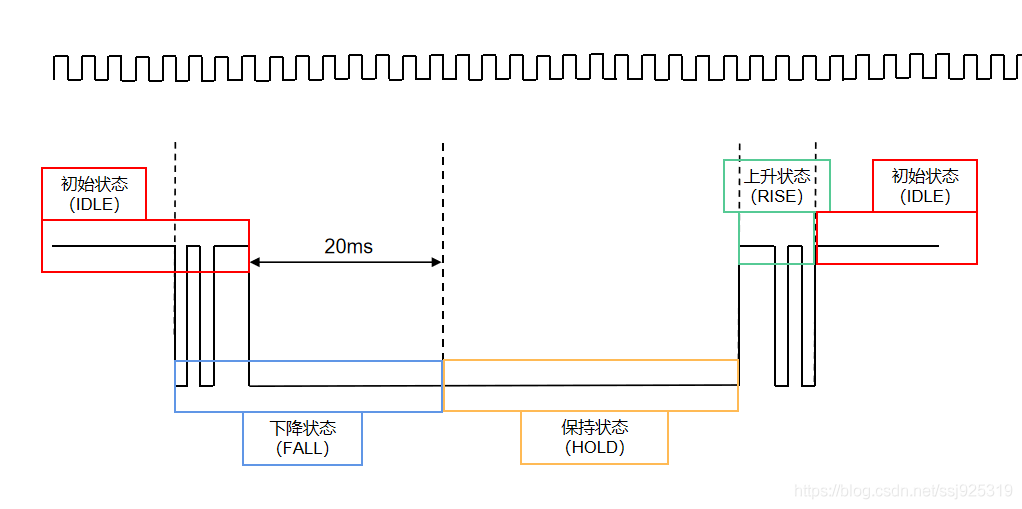1, Principle of state machine
State machine (FSM), also known as finite state machine
One stage state machine
The one-stage state machine seems to solve all logic (including input, output and state) in one always. This writing method seems very concise, but it is often not conducive to maintenance. This writing method is not recommended, but it can still be used in some simple state machines.
Two stage state machine
Two stage state machine is a common writing method. It divides sequential logic and combinatorial logic. The current logic and the next logic are switched in sequential logic, and each input and output and state judgment are realized in combinatorial logic. This writing method is relatively easy to maintain, but the combinatorial logic output is prone to common problems such as burrs.
Three stage state machine
The writing method of three-stage state machine is a recommended writing method. The code is easy to maintain. The output of sequential logic solves the burr problem of combinatorial logic in the two-stage writing method. However, in terms of resource consumption, three-stage consumes more resources. In addition, three-stage input will delay one clock cycle from input to output than one-stage. The three-stage state machine separates sequential logic from combinational logic, and separates state from output, which is clear and easy to understand.
My recommendation is to write a three-stage state machine
2, Design ideas
Key debounce is a relatively simple module with four states
1. Idle (initial state)
2.K_ D (key pressed state)
3.H_ D (press and hold the key to stabilize the value)
4.K_ U (state of key Pop-Up) (this is optional)
Status diagram:

State transition diagram:

Then think about the jump conditions of these States, which is nothing more than the 20ms delay of edge detection and key shaking elimination
assign idle2down = (state_c == IDLE) && nedge;//Falling edge detected assign down2idle = (state_c == DOWN) && (pedge&& end_cnt_20ms);//When the timing is less than 20ms and the rising edge appears, it indicates that the key jitters unexpectedly and returns to the initial state assign down2hold = (state_c == DOWN) && (~pedge && end_cnt_20ms);//When the timing reaches 20ms, there is no rising edge sign, and it remains stable after pressing the key assign hold2up = (state_c == HOLD) && (pedge);//Jump from rising edge to rising state detected assign up2idle = (state_c == UP) && end_cnt_20ms;//The counter counts to 20ms and jumps to the initial state
The rest of the logic is the same as the usual key shaking. You can see the code of my previous blog
[FPGA] key shake elimination in actual combat
3, Code part
The code here is based on the code of my classmates. It's too messy when my code is written. Anyway, this key anti shake module directly copies the code when it needs to be used. The instantiation is finished. Use the key inside_ Just the out signal.
module fsm_key_debounce # (parameter KEY_W = 3,TIME_20MS = 1_000_000)(
input clk ,
input rst_n ,
input [KEY_W - 1:0] key_in ,
output [KEY_W - 1:0] key_out
);
//Parameter definition
localparam IDLE = 4'b0001;//Initial state
localparam DOWN = 4'b0010;//Key press jitter
localparam HOLD = 4'b0100;//Stable after pressing the key
localparam UP = 4'b1000;//Key up jitter
//Signal definition
reg [3:0] state_c;//Present state
reg [3:0] state_n;//Secondary state
//State transition condition definition
wire idle2down;
wire down2idle;
wire down2hold;
wire hold2up ;
wire up2idle ;
reg [KEY_W - 1:0] key_r0;//synchronization
reg [KEY_W - 1:0] key_r1;//Beat
wire [KEY_W - 1:0] nedge;//Falling edge
wire [KEY_W - 1:0] pedge;//Rising edge
//20ms counter
reg [19:0] cnt_20ms;
wire add_cnt_20ms;
wire end_cnt_20ms;
reg [KEY_W - 1:0] key_out_r;//Output register
always@(posedge clk or negedge rst_n)begin
if(!rst_n)begin
state_c <= IDLE;
end
else begin
state_c <= state_n;
end
end
always@(*)begin
case(state_c)
IDLE:begin
if(idle2down)begin
state_n = DOWN;
end
else begin
state_n = state_c;
end
end
DOWN:begin
if(down2idle)begin
state_n = IDLE;
end
else if(down2hold)begin
state_n = HOLD;
end
else begin
state_n = state_c;
end
end
HOLD:begin
if(hold2up)begin
state_n = UP;
end
else begin
state_n = state_c;
end
end
UP:begin
if(up2idle)begin
state_n = IDLE;
end
else begin
state_n = state_c;
end
end
default:state_n = state_c;
endcase
end
assign idle2down = (state_c == IDLE) && nedge;//Falling edge detected
assign down2idle = (state_c == DOWN) && (pedge&& end_cnt_20ms);//When the timing is less than 20ms and the rising edge appears, it indicates that the key jitters unexpectedly and returns to the initial state
assign down2hold = (state_c == DOWN) && (~pedge && end_cnt_20ms);//When the timing reaches 20ms, there is no rising edge sign, and it remains stable after pressing the key
assign hold2up = (state_c == HOLD) && (pedge);//Jump from rising edge to rising state detected
assign up2idle = (state_c == UP) && end_cnt_20ms;//The counter counts to 20ms and jumps to the initial state
//20ms counter
always@(posedge clk or negedge rst_n)begin
if(!rst_n)begin
cnt_20ms <= 0;
end
else if(add_cnt_20ms)begin
if(end_cnt_20ms)begin
cnt_20ms <= 0;
end
else begin
cnt_20ms <= cnt_20ms + 1'b1;
end
end
end
assign add_cnt_20ms = state_c == DOWN || state_c == UP;//Start counting when the key is pressed or bounced
assign end_cnt_20ms = add_cnt_20ms && ((cnt_20ms == TIME_20MS - 1) || pedge);//When the maximum value is counted or a rising edge is detected, the counter is cleared
//Synchronous beat
always@(posedge clk or negedge rst_n)begin
if(!rst_n)begin
key_r0 <= {KEY_W{1'b1}};
key_r1 <= {KEY_W{1'b1}};
end
else begin
key_r0 <= key_in;
key_r1 <= key_r0;
end
end
assign nedge = ~key_r0 & key_r1;//Detect falling edge
assign pedge = key_r0 & ~key_r1;//Detect rising edge
//Key assignment
always@(posedge clk or negedge rst_n)begin
if(!rst_n)begin
key_out_r <= {KEY_W{1'b0}};
end
else if(state_c == HOLD && hold2up)begin
key_out_r <= ~key_r1;
end
else begin
key_out_r <= {KEY_W{1'b0}};
end
end
assign key_out = key_out_r;
endmodule
4, Simulation verification
There is no verification here. You can still go to my previous blog simulation, which is nothing more than adding 4 states and 4 state transition conditions.